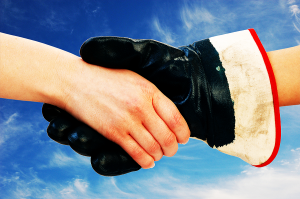Second-Handshake ‘Smoke’: Time to Change Your Business Greetings?

“A commentary in the Journal of the American Medical Association says that it is time to say goodbye to the handshake greeting in a healthcare setting. Or for that measure, goodbye to the goodbye handshake itself.”(To which I would add by logical extension the hello handshake as well, and with definitely greater reluctance, holding hands in any form whatsoever.)
He adds that because the handshake has been believed to be a prime means of spreading germs and diseases, the emergence of dangerous infections like MERS has “injected a new urgency” into the discussion.
This hazard comes on top of the JAMA cited risk of transmission of the Norovirus (200,000 annual fatalities worldwide), Clostridium bacteria (which causes colitis and other gastrointestinal distress), the flu and the common cold.
Interestingly, and perhaps reflecting entrenched cultural resistance to bowing in the Western world, the only alternatives he suggests are a “long-distance wave or salute”. However, let’s not forget that the Germans experimented with the latter for about 15 years, but that didn’t work out too well for them. Ditto for most of the Roman gladiators in the Colosseum on the same issue.
As for the wave as a replacement for the handshake—well, that’s going to look silly when you are about a foot away from a client or candidate, unless one of you is a bubbly teenage Japanese girl with a Mickey Mouse watch on the hand that is waving like a wind-up, wildly swinging, out-of-control Queen Elizabeth gloved pendulum.
The (un)conscious resistance to bowing seems so strong that in a separate CBS Dallas report on the same issue, it was recommended that a hand over the heart or even the fist-bump replace the handshake–fist-bump, with a visiting dignitary, a board member or your uptight boss?
(Who, by the way, would probably feel just as uneasy with a hand-over-the-heart signal vulnerable to being misconstrued as an unwelcome romantic overture.)
So, it seems to me that, by default, that leaves or at least includes bowing as a public health alternative.
Handshake-Free Zones
Now, the recommendation to shake off the handshake was offered in all seriousness in the article and the journal commentary, as was a comparison with the dangers of smoking: “The recommendation is to treat the handshake like smoking…and to have handshake-free zones.” —Although it is unclear whether that was Dr. Hnida’s proposal or the UCLA researchers’.
Given the well-confirmed dangers of so-called “second-hand (secondhand) smoke”, that recommendation and comparison suggests to me the wisdom of viewing the danger as that of the “second-hand handshake”—or “second-hand (shake) illnesses”, especially apt in light of the fact that it is the second hand, i.e., that of the person whose hand is being shaken, that facilitates the spread of infection from one hand to another.
Resilience vs. Resistance
Phasing out the handshake, without resorting to silly waving or scary salutes, won’t be easy—initially. However, cultures, however resistant to change are also remarkably resilient. As I argued in my recent article, “What’s So Bad About Bowing to Customers, Clients, Guests and the Boss? —A Cross-Cultural Analysis “, bowing can preserve our equalitarianism if implemented with the understanding that everyone bows to the same standardized degree, much as we are all encouraged to squeeze hands to the same degree and hold on for the same length of time when shaking hands. No problem.
Yes, initially there is likely to be awkwardness and uncertainty—much like that I experienced yesterday, at a bus terminal in Shin-Yamaguchi, Japan.
Unsure of where my bus bay was located, I asked a very professional-looking woman in a business suit, who, in passing by, could have been on her way to a corporate boardroom.
Like everyone else in the past month+ here in Japan, she was perfectly polite and gracious in trying to help. But, then, things got a little weird.
As I thanked her and was about to head off, she performed, in very rapid succession, about five bows—each a full 90 degrees!—which I would have thought would be normally be reserved for origami (Japanese paper-folding), an audience with the Emperor or a first meeting with a prospective Japanese mother-in-law.
Time to Take Off the Gloves
Of course, you could consider wearing or putting on gloves when greeting clients, candidates and colleagues.
But, if we are going to get serious about dealing with antibiotic-resistant strains of bacteria, constantly morphing viruses and the risks of a global pandemic, it’s clear that it’s about time to take off the gloves—which would themselves become contaminated—and get very serious about changing our infectious ways.
Hence, it is to be hoped that we all adopt the most sensible way to greet each other—bowing—and make it infectious as an idea, unlike the literally infectious handshake.

